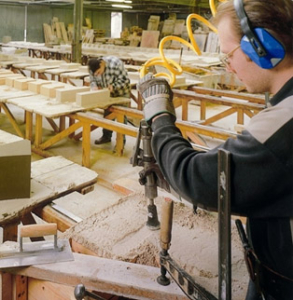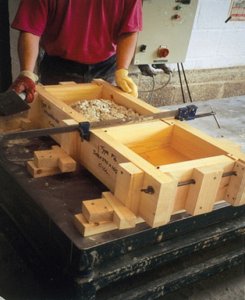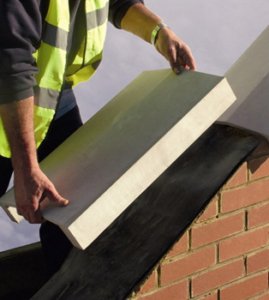Semi-Dry, Wet-Cast or Fibre Reinforced Cast Stone?
The production of cast stone can be an elaborate process. There are as many variations in the precise way UKCSA Full Members go about their art as there are master craftsmen. But there are three main manufacturing methods, semi-dry, wet-cast and fibre reinforced cast stone.
Semi-Dry Cast
The first manufacturing method involves compacting a semi-dry cast stone mix into moulds, and with certain products the finished casting can be demoulded almost immediately for curing.
As the name implies, semi-dry casting involves the use of low water content or ‘earth moist’ mix. The fine aggregates used in the mix are graded so that thorough compaction can be achieved. Computerised batching is typically used to ensure the consistency of materials and measure water content. Semi-dry products can either be manufactured using a high quality cast stone mix throughout or by employing a backing mix with a cast stone facing mix.
The semi-dry approach enables repetitive elements to be cast in considerable numbers and relatively quickly. The finished surface of the semi-dry cast stone products tend to have an open texture, like sawn natural stone.
The process is most suited to traditional sized elements such as cills, heads, string courses and copings. Structural items can be produced so long as the reinforcement requirement does not inhibit compaction. The ability to reinforce semi-dry cast stone is yet another advantage over natural stone.
Units are generally cast face down into wooden moulds using pneumatic or electric sand rammers. Alternatively, steel hand moulding machines or ‘machine mould’ can be used to produce consistently sharp, crisp arrises suitable for ashlar and details such as L quoins and plain band courses. The benefits of machine mould are even shorter lead times and lower cost.
Wet-Cast
The wet cast manufacturing method is similar to casting in plaster and provides a close-grained dense surface. It allows precise rendering of fine detail and, for larger units and structural elements, the use of complex reinforcements.
Wet cast mixes use considerably more water than the semi-dry process and are generally a through mix of the finished face. The mix design is especially critical to the process and the finished appearance.
After the wet-cast mix is poured into the mould, it is compacted using a vibrating table or vacuum casting, or increasingly by the use of self compacting additives.
Wet-cast cast stone units usually require secondary surface finishing and typical techniques include acid etching, grit blasting, hand or mechanical tooling and polishing.
Longer lead times are required for wet-cast cast stone as the process generally yields only one cast per mould per day.
Fibre Reinforced Cast Stone
This process incorporates fibre reinforcement into a higher water content mix that can be either poured or sprayed into moulds, from which the product is demoulded the following day. The incorporation of fibre reinforcing into the wet-cast mix considerably increases the tensile strength of the finished product.
A dense cast stone product with a close face texture is achieved which can be varied by the use of secondary surface treatments.
Often fibre reinforced cast stone units are produced in thin sections which reduces the weight and associated manual handling issues, and offers the opportunity, through careful design and the use of specialist fixings, for retrofitting the fibre reinforced product to the structure.
Longer lead times are required for fibre reinforced cast stone as the process generally yields only one cast per mould per day.



